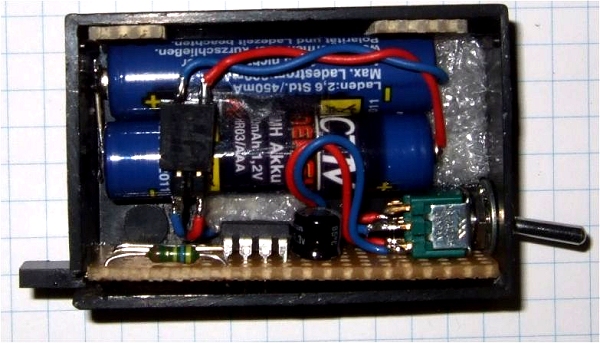Noise Generator with ATTiny15
Digital pseudorandom noise is ususally generated using shift registers with feedback by an exclusive-OR gate to the input. The feedback taps have to be chosen in order to create a maximal-length shift register. See Horowitz & Hill The Art of Electronics, chapter 9.32.
Instead of using real hardware shift registers (e.g. MC4015) a microcontroller can do the job. Just define 6 registers and with the rol command the content is shifted one bit at each clock cycle. An exclusive-OR provides the feedback. The output will look like this
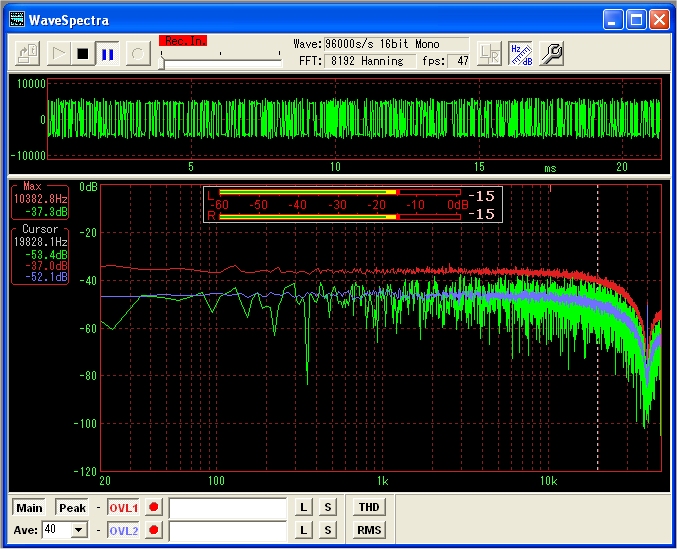
The upper oscilloscope trace shows the pseudorandom bit sequence. Below is the spectrum which is fairly flat below 10 kHz and shows a dip at the clock frequency of 40 kHz. The noise generator's output is normally useful up to 20% of it's clock frequency and would require a simple low pass RC filter. The PC's soundcard sampling frequency is 96000 Hz in this case, so the spectrum's upper frequency limit is 48000 Hz as shown above. This fits quite well with the ATTiny15 clock frequency of 40000 Hz. Of course an ATTiny45 would allow higher clock frequencies
Let's disregard this for a while and see what we can do. Here is a quick test to find the resonance frequency of a parallel LC circuit . Well, it needs the noise generator and a PC with the good Wavespectra software, so much for the equipment. The LC circuit under test is just wired in series between the noise generator and the audio input of the PC.
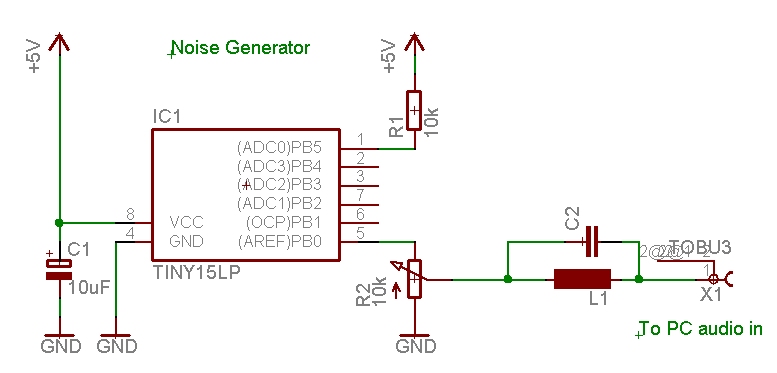
Circuit diagram of the test setup.
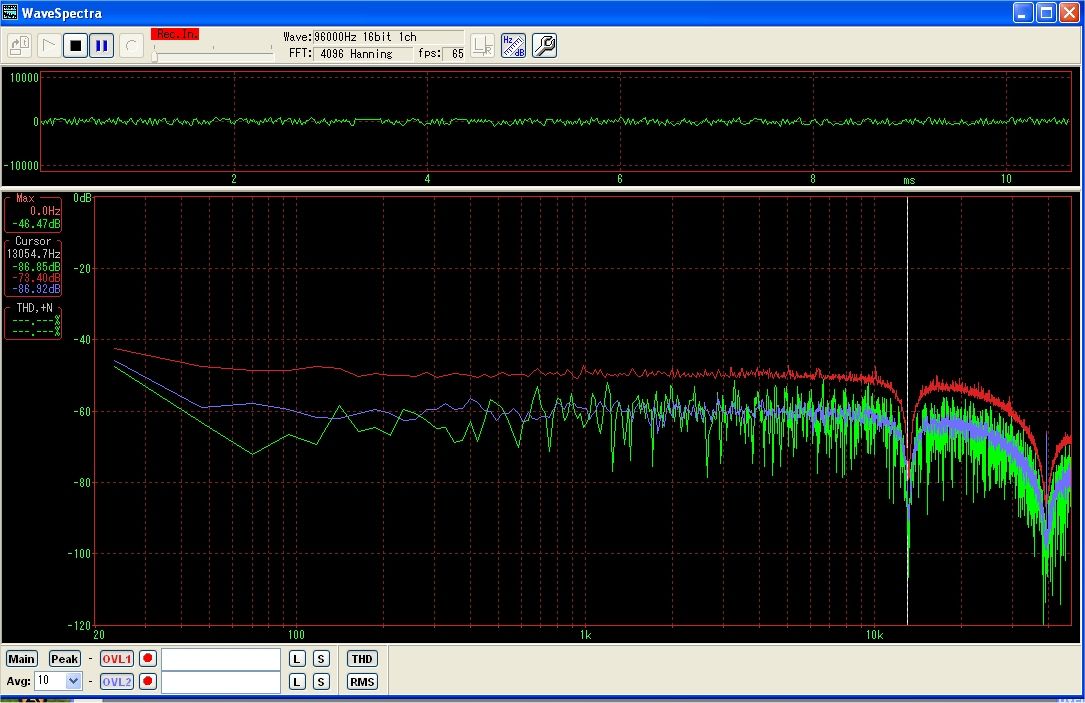
View of a spectrogram of a LC circuit wired in series. The resonance (a dip
in this case) is at 13 kHz. Quick and easy.
Looks worthwhile to build this noisegenerator. Below is a proposal to put it in a Mints box.
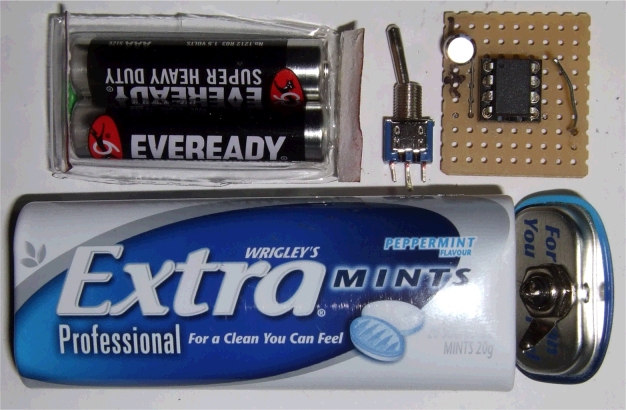
These are the parts needed Then comes the tricky assembly, there is just enough space to get all parts in.
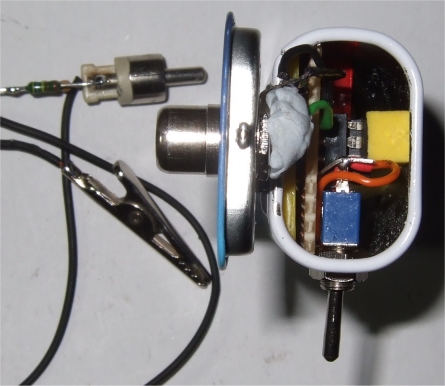
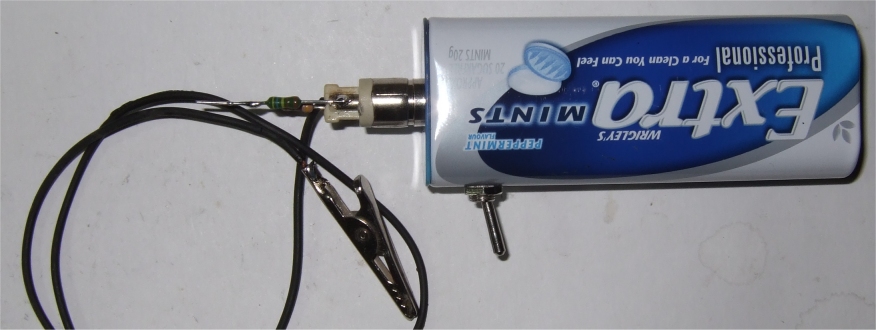
Looks worthwhile to build this noisegenerator. Below is a proposal to put it in a Mints box.

These are the parts needed Then comes the tricky assembly, there is just enough space to get all parts in.


Finally done. On the output is a fixed resistor voltage divider which serves
as a tip to inject the noise.
This 39 bit maximal length noise generator repeats every 549,755,813,887 cycles. With a clock of 40000/sec it takes 13743895.35 seconds, or 3817 hours, or 159 days before the cycle repeats. Gives enough time to complete a measurement.
download NoiseG3.asm
This program is distributed in the hope that it will be useful but WITHOUT ANY WARRANTY;
References
Horowitz & Hill, The Art of Electronics, Cambridge University Press 1980, 1989
David B. VanHorn, dvanhorn@cedar.net
Software for the PC:
Wavespectra software (it's in japanese, so I can't read who programmed it) also recommended: VA -- Visual Analyzer http://www.sillanumsoft.org
Noise-Generator-Anpassung an den Tiny13, Beitrag zum Oster-Contest 2013
Der noise generator geht auch mit dem AT13 mit dem Vorteil einer höheren
Taktfrequenz von 9.6 MHz. Beim AT13 wird die Taktfrequenz per Software
umgeschaltet, so dass man die fuses nicht programmieren muss. Die ISR läuft
jetzt mit 200 kHz und entsprechend flacher ist das Spektrum bis ca. 40 kHz. Mehr
kann die Soundkarte ohnehin nicht.
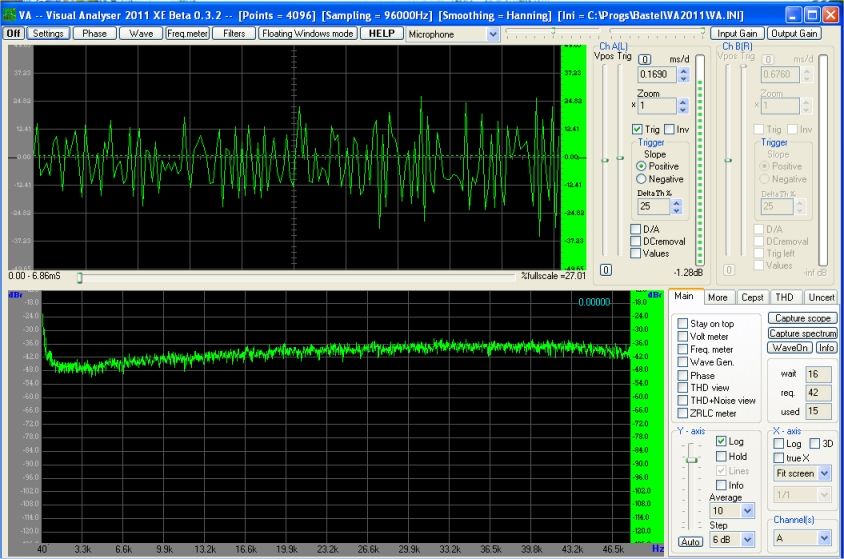
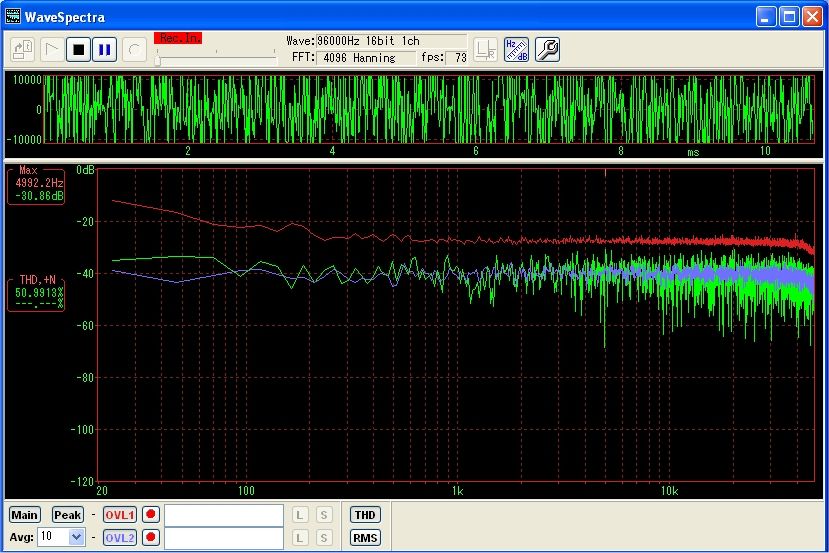
Das Spektrum bei direkter Verbindung zur Soundkarte, also ziemlich flach bis 40 kHz.
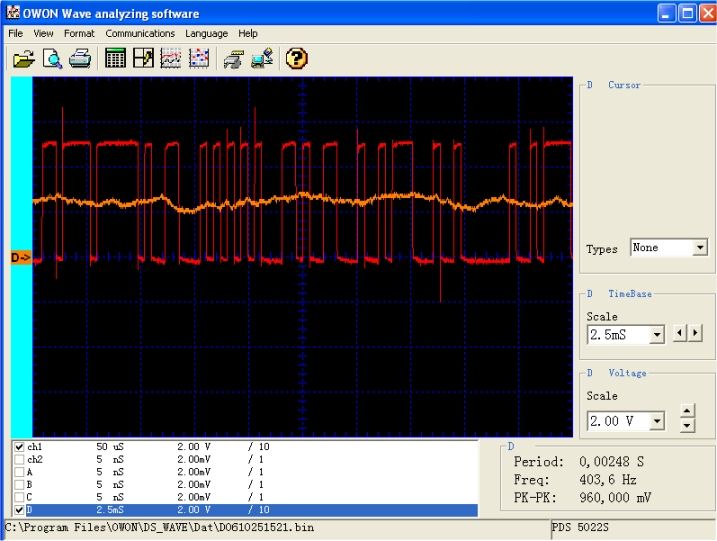
Mit einem einfachen RC Filter mit R 10k und C 100 nF wird das Rauschsignal gefiltert. Die Grenzfrequenz ist bei 1/(2 pi R C) etwa 160 Hz. Im Scope sieht man auch ein relativ flaches Signal in der Mitte, das Spektrum aber hat den RC typischen sanften Abfall zu höheren Frequenzen.
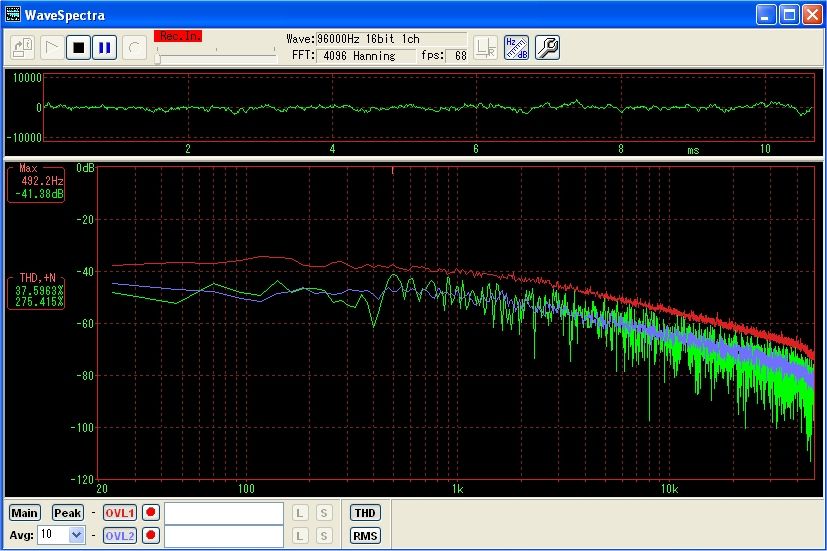
Die
Messung geht sicher schneller als mit einem sweep frequency generator und einem
mV meter.
Download: NoiseG13.zip
;***************************************************************************
;
; ATTiny13 Pseudonoise generator, output on PB0
;
; clock prescaler set by software to 9.6 MHz, 1.042E-07 sec/cycle
; at 9.6 MHz the ISR needs below 3 us to complete, see pulse on PB3
; now reload is set to 5us cycle time or 200 kHz
; there is still some room left (abt 3 us), frequency could be higher
;
; 39 bit maximal length generator. Repeats every 549,755,813,887 cycles
; at 200,000 Hz the repeat is 2.748.779,07 seconds, or
; 763 hours, or 32 days(!)
;
; GS May-2010 - 2013, based on ATtiny15 noiseG3.asm
; original code see eof
;
; This program is free software; you can redistribute it and/or
; modify it under the terms of the GNU General Public License.
; This program is distributed in the hope that it will be useful,
; but WITHOUT ANY WARRANTY;
;
;***************************************************************************
; The timing is adapted for 9.6 MHz
; clock prescaler set to 0 in reset so we have 9.6 MHz clock
;***************************************************************************
;
; Pinout ATtiny13/ATtiny13V 8-PDIP/SOIC
;
;(PCINT5/RESET/ADC0/dW) PB5 VCC
;(PCINT3/CLKI/ADC3) PB3 PB2 (SCK/ADC1/T0/PCINT2)
;(PCINT4/ADC2) PB4 PB1 (MISO/AIN1/OC0B/INT0/PCINT1)
; GND PB0 (MOSI/AIN0/OC0A/PCINT0)
;***************************************************************************
;
; PB4 input not used
; PB3 output set/reset in ISR
; PB2 output noise inverted
; PB1 output not used
; PB0 output noise
;
;***************************************************************************
.DEVICE ATtiny13 ; for gavrasm 3.3
;
;***************************************************************************
;Register Definitions
;***************************************************************************
;
;
.def STEMP = R1 ;
.def PN_A = R2 ;7-0
.def PN_B = R3 ;15-8
.def PN_C = R4 ;23-9
.def PN_D = R5 ;-24
.def PN_E = R6 ;
.def PN_F = R7 ;
.def PN_G = R8 ;
.def T0reload = R15
.def TEMP = r16 ;
.def TEMP2 = r17 ;
.def ITEMP = r18 ;
.def ITEMP2 = r19 ;
;
;
;***************************************************************************
.equ toggle = PB3
.equ noiseinv = PB2
.equ noiseout = PB0
.equ reload = 256 - 48 ; 5 us Timer0
;***************************************************************************
.cseg
.org 0
; ***** INTERRUPT VECTORS **************************************************
rjmp reset
reti ; INT0addr= 0x0001 External Interrupt 0
reti ; PCI0addr= 0x0002 Pin change Interrupt
rjmp TIM0_OVF ; OVF0addr= 0x0003 Timer/Counter0 Overflow
reti
reti
reti
reti
reti
;
;***************************************************************************
;
; Timer/Counter0 Overflow Interrupt
;
;***************************************************************************
TIM0_OVF:
in STEMP,SREG ; Get Status bits
sbi PORTB,toggle ; DEBUG Show we are in the ISR
out TCNT0,T0reload ; for 5 us Interrupt
;Generate the feedback from bits 39,35 (NOTE! Hill uses 1,2,3,4 numbering)
clr ITEMP ;
clr ITEMP2 ;
sbrc PN_E,6 ;39
sbr ITEMP,1<<0 ;XXXXXXXA
sbrc PN_E,2 ;35
sbr ITEMP2,1<<0 ;XXXXXXXB
eor ITEMP2,ITEMP ;Xor
ror ITEMP2 ;Put bit 0 in carry
;Shift everyone over, and the carry into the register.
;104 bits long. If you use maximal length, this will last
;way longer than the universe.
;Bits Hill's bits
rol PN_A ;7-0 8-1
rol PN_B ;15-8 16-9
rol PN_C ;23-16 and so on
rol PN_D ;31-17
rol PN_E ;39-32 40-33
rol PN_F ;47-40
;Output the bit
sbrs PN_A,1 ;
rjmp Output_Zero ;
sbi PORTB, noiseout ; set
cbi PORTB, noiseinv ; clear
rjmp TIM0_DONE ;
Output_Zero:
cbi PORTB, noiseout ; clear
sbi PORTB, noiseinv ; set
TIM0_DONE:
cbi PORTB,toggle ;toggle output off
out SREG,STEMP ;Put the status bits back
reti ;
;
;***************************************************************************
reset:
; writing the calibration byte to the OSCCAL Register.
;ldi temp,0x7A ; config val
;out OSCCAL,temp ; for the cpu clock
;nop
;nop
ldi temp,0b11110000
out PORTB,temp
ldi temp,0b00001111
out DDRB,temp
ldi temp,0b10000000 ; turn off analog comp.
out ACSR,temp
ldi temp,0b10000000 ; clock prescaler change enable
out CLKPR,temp
ldi temp,0b00000000 ; clock prescaler set to 0
out CLKPR,temp
nop ; wait a little when switching
nop
nop
nop
; timer0 setup:
ldi temp,0b00000010 ; Bit 1 – TOIE0: Timer/Counter0 Overflow Interrupt Enable
out TIFR0,temp ; clear pending Interrupt
out TIMSK0,temp ; in the Timer Interupt Mask Register
ldi temp,0b00000001 ; Timer/Counter 0 clocked at CK/1
out TCCR0B,temp ; 9,6 Mhz
ldi temp, reload ; Timer/Counter 0 reload
out TCNT0,temp ; for 5 us Interrupt
mov T0reload, temp
ldi TEMP,$55 ; Init the PN generator
mov PN_A,TEMP ;
mov PN_B,TEMP ;
mov PN_C,TEMP ;
mov PN_D,TEMP ;
mov PN_E,TEMP ;
mov PN_F,TEMP ;
sei ; enable interrupts
Idle: ;
rjmp Idle ; That's all we do.
;
;***************************************************************************
;Some other two tap point SR combinations, from Art of Electronics
;Note, hill counts bits as 1,2,3,4, not 0,1,2,3
;Tap points Length
;3,2 7
;4,3 15
;5,3 31
;6,5 63
;7,6 127
;9,5 511
;10,7 1,023
;11,9 2,047
;15,14 32,767
;17,14 131,071
;18,11 262,143
;20,17 1,048,575
;21,19 2,097,151
;22,21 4,194,303
;23,18 8,388,607
;25,22 33,554,431
;28,25 268,435,455
;29,27 536,870,911
;31,28 2,147,483,647
;33,20 8,589,934,591
;35,33 34,359,738,367
;36,25 68,719,476,735
;39,35 549,755,813,887
;
;A 100 bit register, clocked at 10 mHz would outlast the age
;of the universe, by 1,000,000 times.
;
;***************************************************************************
; Noisy Box M A I N M O D U L E
;
; Date ;6/30/04
; Version :1.00
; Support telephone :765 287 1989 David B. VanHorn
; Support Email :dvanhorn@cedar.net
; Target MCU :Atmel Tiny-11
;
; DESCRIPTION
;
; Pseudonoise generator, output on B0.
;
;***************************************************************************
;***************************************************************************
;
; Atiny15 Pseudonoise generator, output on B0
; ISR fires at 40 kHz @ 1.6 MHz, that's the AT15 limit
; AT45 use a 8 Mhz clock frequency -> 200 kHz ISR
; no matter what, the interrupt needs abt 40 cycles to complete
;
; GS May-2010
; original code see eof
;
; This program is free software; you can redistribute it and/or
; modify it under the terms of the GNU General Public License.
; This program is distributed in the hope that it will be useful,
; but WITHOUT ANY WARRANTY;
;
;***************************************************************************
; The timing is adapted for 1.6 MHz
; this At15 reads OSCCAL config val=0x7A
;***************************************************************************
; ATtiny15 dip
; (RESET/ADC0) PB5 VCC
; (ADC3) PB4 PB2 (ADC1/SCK/T0/INT0)
; (ADC2) PB3 PB1 (AIN1/MISO/OC1A)
; GND PB0 (AIN0/AREF/MOSI)
;***************************************************************************
;
; PB4 input not used
; PB3 output set/reset in ISR
; PB2 output noise inverted
; PB1 output toggle OC1A
; PB0 output noise
;
;***************************************************************************
.DEVICE ATtiny15 ;for gavrasm
;
;***************************************************************************
;Register Definitions
;***************************************************************************
;
;
.def STEMP = R1 ;
.def PN_A = R2 ;7-0
.def PN_B = R3 ;15-8
.def PN_C = R4 ;23-9
.def PN_D = R5 ;-24
.def PN_E = R6 ;
.def PN_F = R7 ;
.def PN_G = R8 ;
.def TEMP = R16 ;
.def TEMP2 = R17 ;
.def ITEMP = R18 ;
.def ITEMP2 = R19 ;
;
;
;***************************************************************************
.equ toggle = PB3
.equ noiseinv = PB2
.equ noiseout = PB0
.equ topcount = 40-1 ; 40 kHz @ 1.6 MHz
;***************************************************************************
.cseg
.org 0
; ***** INTERRUPT VECTORS **************************************************
rjmp reset ; Reset-vector address 0000
reti ; INT0addr= 0x0001 External Interrupt 0
reti ; PCI0addr= 0x0002 Pin Interrupt Request
rjmp TIM1_cmp ; OC1addr = 0x0003 Timer/Counter1 Compare Match
reti ; OVF1addr= 0x0004 Timer/Counter1 Overflow
reti ; OVF0addr= 0x0005 Timer/Counter0 Overflow
reti ; ERDYaddr= 0x0006 EEPROM Ready
reti ; ACIaddr = 0x0007 Analog Comparator
reti ; ADCCaddr= 0x0008 ADC Conversion Ready
;;
;***************************************************************************
;
;Timer Tick 40kHz
;
TIM1_cmp:
in STEMP,SREG ;Get Status bits
sbi PORTB,toggle ;DEBUG Show we are in the ISR
;***************************************************************************
;39 bit maximal length generator. Repeats every 549,755,813,887 cycles
;40,000 clk/sec, so the repeat is 13743895.35 seconds, or
;3817 hours, or 159 days(!)
;Generate the feedback from bits 39,35 (NOTE! Hill uses 1,2,3,4 numbering)
clr ITEMP ;
clr ITEMP2 ;
sbrc PN_E,6 ;39
sbr ITEMP,1<<0 ;XXXXXXXA
sbrc PN_E,2 ;35
sbr ITEMP2,1<<0 ;XXXXXXXB
eor ITEMP2,ITEMP ;Xor
ror ITEMP2 ;Put bit 0 in carry
;Shift everyone over, and the carry into the register.
;104 bits long. If you use maximal length, this will last
;way longer than the universe.
;Bits Hill's bits
rol PN_A ;7-0 8-1
rol PN_B ;15-8 16-9
rol PN_C ;23-16 and so on
rol PN_D ;31-17
rol PN_E ;39-32 40-33
rol PN_F ;47-40
;Output the bit
sbrs PN_A,1 ;
rjmp Output_Zero ;
sbi PORTB, noiseout ; set
cbi PORTB, noiseinv ; clear
rjmp TIM1_DONE ;
Output_Zero:
cbi PORTB, noiseout ; clear
sbi PORTB, noiseinv ; set
TIM1_DONE:
cbi PORTB,toggle ;toggle output off
out SREG,STEMP ;Put the status bits back
reti ;
;
;***************************************************************************
reset:
; writing the calibration byte to the OSCCAL Register.
ldi temp,0x7A ; config val
out OSCCAL,temp ; for the cpu clock
nop
nop
ldi temp,0b11110000
out PORTB,temp
ldi temp,0b00001111
out DDRB,temp
ldi temp,0b10000000 ;turn off analog comp.
out ACSR,temp
; timer setup:
ldi TEMP,$55 ; Init the PN generator
mov PN_A,TEMP ;
mov PN_B,TEMP ;
mov PN_C,TEMP ;
mov PN_D,TEMP ;
mov PN_E,TEMP ;
mov PN_F,TEMP ;
ldi temp, topcount ; Timer/Counter 1 top count
out OCR1A,temp ; compare value
ldi temp, 0b10010101 ; Timer/Counter 1 ctc, toggle OC1A, use sysCK
out TCCR1,temp ;
ldi temp, 0b01000000 ; enable OCIE1A interrupt
out TIMSK,temp
sei ; enable interrupts
Idle: ;
rjmp Idle ; That's all we do.
;
;***************************************************************************
;Some other two tap point SR combinations, from Art of Electronics
;Note, hill counts bits as 1,2,3,4, not 0,1,2,3
;Tap points Length
;3,2 7
;4,3 15
;5,3 31
;6,5 63
;7,6 127
;9,5 511
;10,7 1,023
;11,9 2,047
;15,14 32,767
;17,14 131,071
;18,11 262,143
;20,17 1,048,575
;21,19 2,097,151
;22,21 4,194,303
;23,18 8,388,607
;25,22 33,554,431
;28,25 268,435,455
;29,27 536,870,911
;31,28 2,147,483,647
;33,20 8,589,934,591
;35,33 34,359,738,367
;36,25 68,719,476,735
;39,35 549,755,813,887
;
;A 100 bit register, clocked at 10 mHz would outlast the age
;of the universe, by 1,000,000 times.
;
;***************************************************************************
; Noisy Box M A I N M O D U L E
;
; Date ;6/30/04
; Version :1.00
; Support telephone :765 287 1989 David B. VanHorn
; Support Email :dvanhorn@cedar.net
; Target MCU :Atmel Tiny-11
;
; DESCRIPTION
;
; Pseudonoise generator, output on B0.
;
;***************************************************************************

